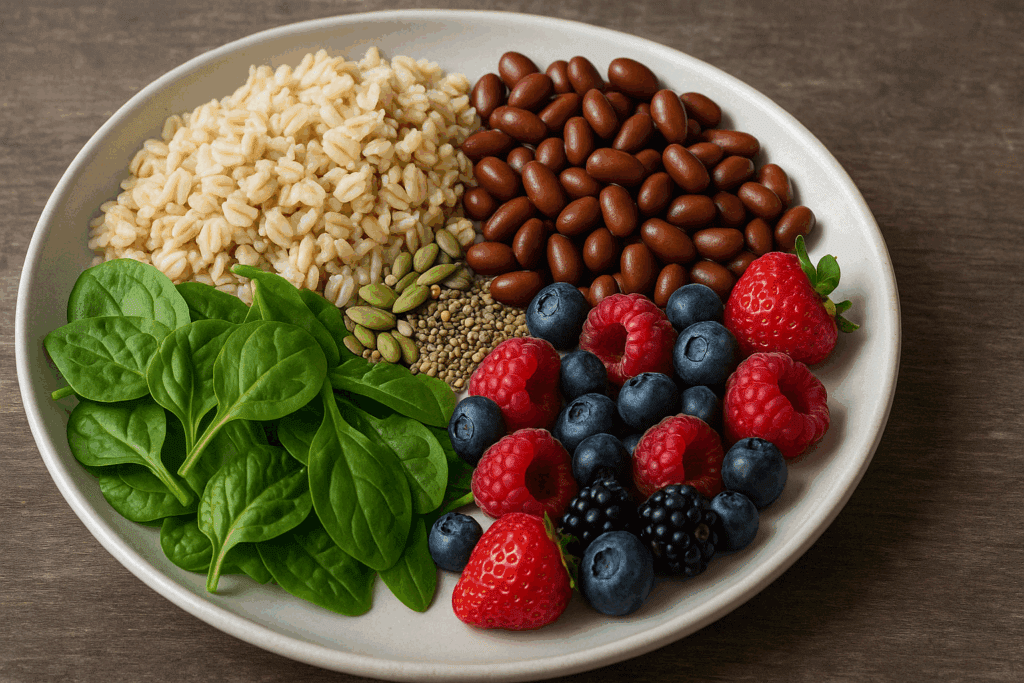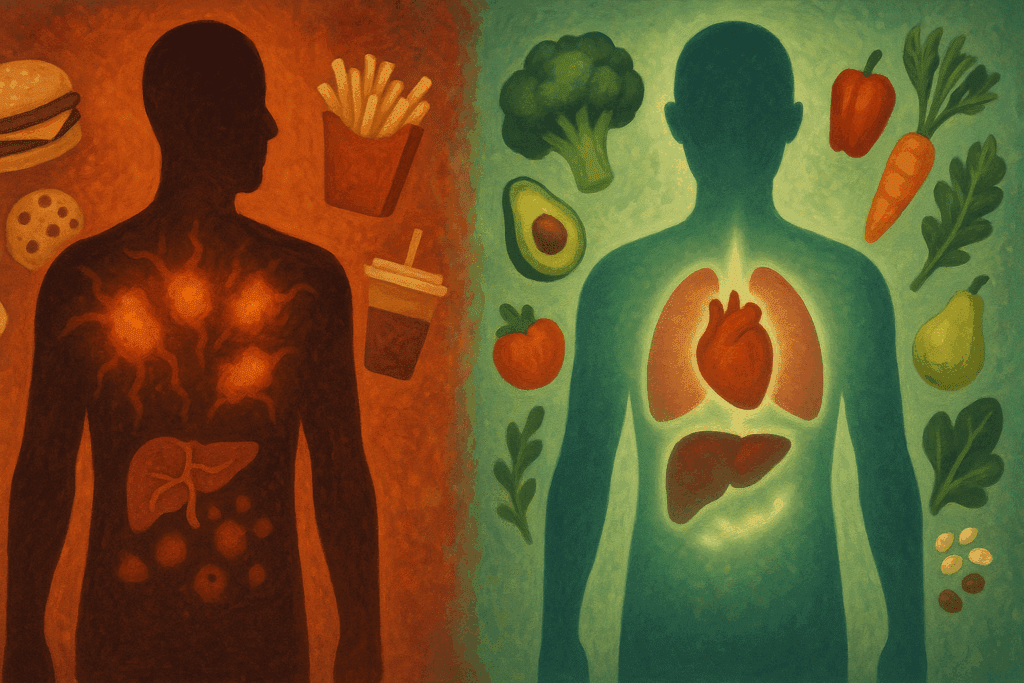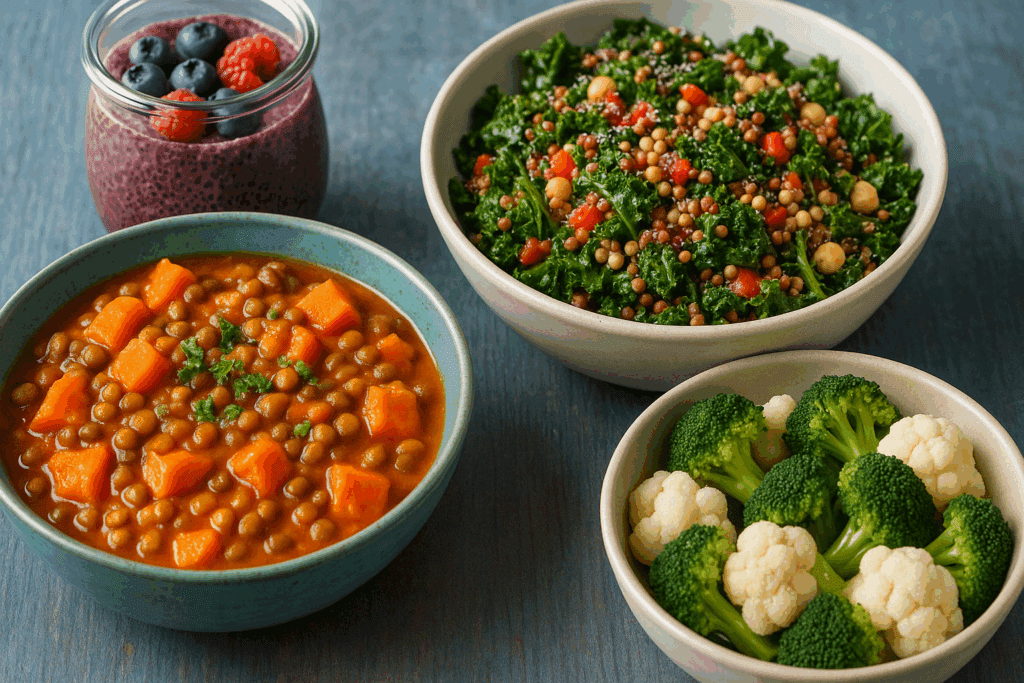Understanding how diet influences diabetes management has been a cornerstone of medical nutrition therapy for decades. As rates of type 2 diabetes continue to rise globally, the search for sustainable, effective, and natural dietary strategies has led many healthcare professionals and researchers to revisit the powerful role of plant-based nutrition. Among these, whole food plant-based (WFPB) diets have emerged as a particularly compelling approach for supporting stable blood sugar levels and reducing the risk of complications associated with diabetes. By emphasizing unprocessed or minimally processed fruits, vegetables, legumes, whole grains, nuts, and seeds, whole food plant-based recipes for diabetics offer both nutritional density and glycemic control. When these meals are crafted thoughtfully, they not only provide the right balance of macronutrients but also help reduce inflammation, improve insulin sensitivity, and enhance overall metabolic health.
You may also like: Healthy Plant-Based Dinners Made Easy: Best Whole Food Plant-Based Recipes for Beginners and Beyond
Many people newly diagnosed with diabetes or those struggling with glucose management often feel overwhelmed by restrictive or overly complex diet plans. The appeal of WFPB nutrition lies in its simplicity and its alignment with the natural way our bodies are designed to process nutrients. Unlike highly refined diets that spike blood sugar and contribute to insulin resistance, whole food plant-based recipes for diabetics are built around ingredients that digest slowly, support healthy gut microbiota, and reduce oxidative stress. From hearty lentil stews to fiber-rich grain bowls, these meals offer satiety and stability in a way that heavily processed diets simply cannot match. What makes them especially potent is their ability to work synergistically with the body’s natural insulin production, often reducing the need for medication over time under medical supervision.
This article delves into the evidence-based benefits of WFPB eating for diabetes management and offers practical guidance for incorporating expert-backed meals into everyday life. It draws upon peer-reviewed scientific research, clinical insights, and culinary wisdom to present vegan recipes for diabetics that are not only nutritionally sound but also deeply satisfying. Through a rich blend of science and storytelling, we aim to equip readers with the knowledge and tools to embrace this transformative way of eating, one wholesome bite at a time.

Why Whole Food Plant-Based Eating Supports Blood Sugar Control
The efficacy of whole food plant-based diets in promoting glycemic control is well documented in the scientific literature. One of the primary mechanisms behind this benefit is the high fiber content inherent in WFPB foods. Dietary fiber—especially soluble fiber found in foods like oats, legumes, and certain fruits—slows the absorption of glucose into the bloodstream, helping to prevent rapid spikes in blood sugar. This gradual glucose release not only reduces the glycemic load of meals but also contributes to sustained energy levels and diminished cravings.
Moreover, WFPB diets tend to be naturally lower in saturated fat, which is significant because saturated fat has been linked to increased insulin resistance—a core issue in type 2 diabetes. When insulin resistance is reduced, the body’s ability to utilize glucose effectively improves, leading to better blood sugar readings and, over time, a lower HbA1c. By removing or minimizing animal products and processed oils, vegan recipes for diabetics help eliminate dietary sources of saturated fat and trans fat, replacing them with healthier unsaturated fats from sources like avocado, flaxseed, and walnuts.
In addition to fiber and fat quality, the phytonutrient content of plant-based foods cannot be overlooked. Compounds such as flavonoids, polyphenols, and carotenoids possess antioxidant and anti-inflammatory properties that can help protect pancreatic beta cells, the insulin-producing cells often compromised in diabetes. These bioactive compounds are found abundantly in colorful vegetables, fruits, herbs, and spices—ingredients that are foundational to whole food plant-based recipes for diabetics. Through their synergistic action, these compounds enhance insulin sensitivity and may help reduce the risk of long-term complications such as cardiovascular disease and neuropathy.
Finally, plant-based diets are associated with improved weight management, which is a crucial aspect of diabetes care. Obesity, particularly visceral fat accumulation, is a major contributor to insulin resistance. Whole food plant-based eating naturally encourages a lower calorie density while preserving satiety, allowing individuals to reduce excess weight without excessive restriction or hunger. The result is a sustainable dietary pattern that supports both short-term glycemic control and long-term health outcomes.
Expert-Backed Nutritional Principles for Diabetics
A successful dietary strategy for managing diabetes must be grounded in evidence-based nutritional principles, tailored to individual needs, and sustainable over the long term. For those embracing vegan recipes for diabetics, a few core tenets can help guide meal planning and food selection to optimize metabolic health. One of the most important is the emphasis on complex carbohydrates over simple sugars. While carbohydrates are often feared in diabetic circles, the type and source of carbohydrate matter more than the quantity alone. Whole grains like quinoa, barley, and steel-cut oats provide slow-digesting carbohydrates paired with fiber, protein, and essential nutrients, making them excellent staples in a diabetic-friendly plant-based diet.
Protein is another key macronutrient that deserves attention. In a WFPB context, high-quality plant-based proteins from legumes, lentils, tempeh, tofu, and even some whole grains help stabilize blood sugar and support muscle maintenance. Unlike animal-based proteins, these sources come with additional fiber and phytonutrients that offer further health benefits. Adequate protein intake is particularly important for individuals managing blood sugar fluctuations during physical activity or weight loss, both of which can influence insulin sensitivity and glucose metabolism.
Fats in a WFPB diet should be derived primarily from whole sources rather than extracted oils. Avocados, nuts, seeds, and olives provide essential fatty acids that support heart health—a significant consideration given the increased cardiovascular risk associated with diabetes. These fats also aid in nutrient absorption and contribute to meal satisfaction, making them an integral part of vegan recipes for diabetics. Importantly, they should be consumed in moderation and balanced with other macronutrients to ensure optimal metabolic control.
Micronutrient adequacy is another important consideration. While a well-planned WFPB diet can meet all essential nutrient needs, certain nutrients such as vitamin B12, vitamin D, and omega-3 fatty acids may require supplementation or careful food selection. Fortified plant-based milks, nutritional yeast, and algae-based omega-3 supplements can help address potential gaps. Iron and zinc absorption can be enhanced by combining plant sources with vitamin C-rich foods, further illustrating the importance of thoughtful meal construction.
Hydration, meal timing, and portion control also play essential roles in blood sugar regulation. Drinking enough water helps support kidney function and glucose elimination, while consistent meal timing can prevent blood sugar fluctuations. Eating at regular intervals with balanced macronutrients can help individuals avoid hypoglycemia and promote a more predictable insulin response. These practices, when combined with whole food plant-based recipes for diabetics, create a strong foundation for stable and responsive blood glucose control.

Designing Delicious and Functional Plant-Based Meals for Diabetes
Creating flavorful and functional plant-based meals that support healthy blood sugar levels requires both culinary creativity and nutritional insight. Fortunately, the variety and richness of whole plant foods offer endless opportunities for crafting meals that are both satisfying and metabolically beneficial. The key is to focus on balance and synergy—combining ingredients in ways that support satiety, slow digestion, and nutrient density.
A well-composed diabetic-friendly vegan meal typically includes a base of fiber-rich complex carbohydrates, such as farro, brown rice, or sweet potatoes. These ingredients provide the bulk of energy while offering important vitamins and minerals. To this base, legumes like black beans, chickpeas, or lentils are added for protein, additional fiber, and blood sugar-modulating effects. Leafy greens and cruciferous vegetables such as kale, spinach, broccoli, and Brussels sprouts bring not only antioxidants and vitamins but also contribute to slower carbohydrate absorption through their fiber content.
Flavor and variety are enhanced by incorporating herbs and spices like turmeric, cinnamon, ginger, and garlic—all of which have been studied for their potential blood sugar-lowering effects. For instance, cinnamon has been shown to improve insulin sensitivity in some individuals, while turmeric’s curcumin content exhibits anti-inflammatory and antioxidant benefits. These ingredients not only elevate the flavor profile of vegan recipes for diabetics but also add functional value to every dish.
Healthy fats from sources like chia seeds, flaxseeds, walnuts, and avocado can be sprinkled into salads, stirred into oatmeal, or blended into sauces to enhance the richness of meals. These fats help slow digestion, which further stabilizes blood sugar levels. In addition, fermented foods like tempeh, sauerkraut, and kimchi support gut health, which has emerging links to metabolic health and glucose regulation.
Desserts and snacks, often challenging for individuals with diabetes, can also be tailored to fit a WFPB lifestyle. Instead of refined sugar-laden treats, options like chia pudding with unsweetened almond milk, fruit-sweetened energy bites, or baked apples with cinnamon provide natural sweetness without compromising glycemic control. With thoughtful preparation, it becomes entirely possible to enjoy a wide range of meals and flavors while maintaining stable blood sugar.

The Science Behind Plant-Based Diets and Diabetes Remission
A growing body of research supports the potential of plant-based diets not only to manage but in some cases to reverse type 2 diabetes under medical supervision. Clinical trials and observational studies have demonstrated that individuals adhering to whole food plant-based diets often experience significant improvements in insulin sensitivity, fasting glucose levels, and overall metabolic function. One landmark study published in the journal Nutrients found that participants following a WFPB diet for 16 weeks showed greater reductions in HbA1c and body weight compared to those on standard diabetic diets.
What sets WFPB nutrition apart is its ability to address the root causes of insulin resistance, including inflammation, lipid accumulation in muscle and liver tissue, and oxidative stress. By removing animal products and processed foods that contribute to these conditions, and replacing them with anti-inflammatory, antioxidant-rich plant foods, individuals create an internal environment more conducive to metabolic healing. This does not imply a cure for diabetes, but rather a powerful tool in its long-term management.
Furthermore, studies have shown that plant-based diets are associated with a reduced risk of developing type 2 diabetes in the first place. A review in the journal JAMA Internal Medicine highlighted that individuals consuming diets rich in whole plant foods had a significantly lower risk of developing diabetes compared to those consuming higher amounts of animal products and processed foods. These findings reinforce the preventative and therapeutic potential of WFPB eating.
Importantly, the benefits of vegan recipes for diabetics are not limited to blood sugar control. Improvements in lipid profiles, blood pressure, kidney function, and overall cardiovascular health have also been observed. This is especially critical since individuals with diabetes are at increased risk for cardiovascular complications. The interconnected nature of these health metrics underscores the systemic benefits of adopting a whole food plant-based lifestyle.
Healthcare professionals, including registered dietitians and endocrinologists, increasingly recognize the value of plant-based nutrition in diabetes care. While more long-term, large-scale studies are needed, the existing evidence strongly supports the integration of whole food plant-based recipes for diabetics into mainstream dietary recommendations.

Transitioning to a WFPB Lifestyle: Practical Tips and Considerations
Making the shift to a WFPB lifestyle can be both empowering and overwhelming, particularly for those managing a chronic condition like diabetes. One of the first steps in a successful transition is understanding that perfection is not the goal—consistency and progress are. Starting with one plant-based meal per day or committing to a plant-based day each week can lay the groundwork for lasting dietary change.
Grocery shopping becomes a central part of this transition. Learning to navigate the produce section, bulk bins, and plant-based product aisles with confidence is crucial. Stocking up on essentials like dried or canned beans, whole grains, fresh and frozen vegetables, nuts, and seeds ensures that you always have the building blocks of healthy meals on hand. Reading labels for hidden sugars, oils, and preservatives is also a critical skill as you become more discerning in your food choices.
Meal prep can be an invaluable tool for staying on track. Preparing batches of grains, legumes, and chopped vegetables in advance can significantly reduce the time needed to assemble meals during a busy week. Investing in high-quality kitchen tools, like a pressure cooker or high-speed blender, can also make cooking WFPB meals more efficient and enjoyable.
Support and education play pivotal roles in long-term success. Joining online communities, following plant-based health professionals, and participating in cooking classes or workshops can provide both inspiration and accountability. Moreover, working with a registered dietitian who specializes in plant-based nutrition and diabetes care can offer personalized guidance and help troubleshoot challenges as they arise.
Finally, it’s important to maintain open communication with your healthcare provider throughout this journey. As blood sugar improves, medication adjustments may become necessary to prevent hypoglycemia. Monitoring your progress and celebrating milestones—no matter how small—can reinforce the sense of empowerment and agency that comes from nourishing your body with whole, plant-based foods.

Frequently Asked Questions: Whole Food Plant-Based Recipes for Diabetics
1. Can whole food plant-based recipes for diabetics be adapted for cultural cuisines?
Absolutely. One of the lesser-discussed benefits of whole food plant-based recipes for diabetics is their adaptability to diverse culinary traditions. Whether you’re inspired by Indian lentil dals, Ethiopian injera and stews, Latin American black bean dishes, or Mediterranean grain bowls, it’s entirely possible to modify these dishes to support healthy blood sugar levels. The key lies in using whole ingredients such as legumes, whole grains, fresh herbs, and naturally low-glycemic vegetables, while avoiding added sugars, refined flours, or processed oils. This not only preserves cultural authenticity but also ensures nutritional integrity. Embracing global flavors keeps meals exciting and sustainable, especially for those newly transitioning to plant-based eating.
2. Are there specific cooking techniques that enhance the effectiveness of vegan recipes for diabetics?
Yes, cooking methods can significantly influence how a food affects blood sugar. For example, roasting vegetables can concentrate natural sugars, potentially increasing glycemic impact, whereas steaming or blanching helps preserve fiber and reduces spikes. Soaking and sprouting legumes and whole grains can also lower their glycemic index and enhance digestibility, which is particularly helpful for blood sugar regulation. Sautéing with water or vegetable broth instead of oil is a common practice in whole food plant-based recipes for diabetics, as it reduces unnecessary fat that could impair insulin sensitivity. Even meal composition—such as combining healthy fats with fiber and protein—can delay glucose absorption and create a more balanced glycemic response.
3. How do vegan recipes for diabetics support gut health, and why does this matter for blood sugar?
Gut health plays a surprisingly critical role in diabetes management. Vegan recipes for diabetics often include prebiotic-rich foods like onions, garlic, legumes, and whole grains that nourish beneficial gut bacteria. A diverse microbiome has been linked to improved insulin sensitivity and reduced inflammation—two factors that are vital in stabilizing blood sugar levels. Additionally, fermented plant foods like tempeh, sauerkraut, and miso introduce probiotics, which further enhance gut integrity and metabolic function. These benefits underscore why whole food plant-based recipes for diabetics should prioritize gut-friendly ingredients as part of a comprehensive nutritional approach.
4. Is it possible to follow a WFPB diabetic diet while dining out or traveling?
It can be challenging, but with preparation, it’s absolutely achievable. Many restaurants now offer vegan and gluten-free options that can be customized to align with whole food plant-based recipes for diabetics. The key is to ask for modifications, such as skipping sugary dressings, opting for steamed instead of fried dishes, and requesting whole grains if available. When traveling, bringing shelf-stable staples like unsweetened oatmeal packets, roasted chickpeas, or homemade trail mix can help bridge nutritional gaps. Practicing mindful portion control and prioritizing fiber-rich plant foods helps maintain stable glucose levels, even in less predictable food environments.
5. Can whole food plant-based recipes for diabetics help with reducing medication dependency?
Emerging research and anecdotal reports suggest that, under medical supervision, some individuals can reduce or even discontinue certain diabetes medications when they consistently follow a WFPB diet. This isn’t a guarantee, nor should it be attempted without guidance, but the potential exists due to the diet’s ability to address root causes like insulin resistance and chronic inflammation. Vegan recipes for diabetics that emphasize low-glycemic foods, soluble fiber, and anti-inflammatory nutrients may improve HbA1c and fasting glucose levels over time. However, medication adjustments should always be managed by a healthcare provider to avoid risks such as hypoglycemia.
6. What are some lesser-known ingredients that can enhance vegan recipes for diabetics?
Beyond the usual staples, several underutilized ingredients offer exceptional benefits for blood sugar regulation. Amaranth, a pseudo-grain rich in fiber and micronutrients, has a low glycemic index and cooks quickly. Sea vegetables like wakame and dulse provide iodine and antioxidants, supporting thyroid and metabolic function. Herbs such as fenugreek and bitter melon, used in various traditional medicines, have demonstrated glucose-lowering properties in clinical studies. These ingredients not only diversify vegan recipes for diabetics but also contribute unique textures and flavors that keep meals interesting. Incorporating a wider range of plant foods supports micronutrient sufficiency and long-term dietary adherence.
7. How can someone overcome emotional or social barriers when switching to whole food plant-based recipes for diabetics?
Shifting to a plant-based diet can be emotionally complex, especially when food traditions, social events, or family expectations come into play. One effective strategy is to involve loved ones in meal preparation using delicious whole food plant-based recipes for diabetics that appeal to everyone, not just those managing diabetes. Hosting plant-based potlucks or bringing your own dish to gatherings helps reduce social pressure while showcasing how tasty and inclusive this lifestyle can be. Emotional barriers can also stem from feeling deprived—address this by exploring plant-based versions of favorite comfort foods using wholesome ingredients. Gradual transition, community support, and focusing on the empowering aspects of health transformation often make the journey more enjoyable and sustainable.
8. Are there time-saving strategies for preparing whole food plant-based recipes for diabetics during a busy week?
Yes, meal prep is a cornerstone of success, especially for those balancing work, family, and health goals. One effective tactic is batch-cooking key components such as brown rice, lentils, and roasted vegetables at the beginning of the week. Pre-chopping produce, freezing smoothie packs, and storing homemade salad dressings can streamline weekday cooking. Additionally, using an Instant Pot or slow cooker to prepare soups and stews is particularly helpful for crafting nutrient-dense vegan recipes for diabetics with minimal hands-on time. With these strategies, you can quickly assemble meals that are both nourishing and blood sugar-friendly, even on the busiest days.
9. How do seasonal changes affect the planning of whole food plant-based meals for diabetics?
Seasonal variation in produce allows for creative, nutrient-rich adaptations that support metabolic health. In summer, fresh berries, cucumbers, and zucchini can be used in chilled soups and salads that are light yet blood sugar-friendly. Autumn introduces root vegetables and cruciferous options like Brussels sprouts, which pair beautifully with warming grains and legumes. Winter encourages hearty stews with lentils, beans, and seasonal squashes, while spring offers a bounty of leafy greens and detoxifying herbs. Adapting whole food plant-based recipes for diabetics according to seasonal availability enhances flavor, ensures nutrient diversity, and can even reduce grocery costs.
10. What innovations or future trends are emerging in vegan recipes for diabetics?
The field is rapidly evolving, with exciting innovations aimed at improving accessibility and personalization. Artificial intelligence and wearable glucose monitors are being used to tailor meal planning based on individual glycemic responses, creating new potential for customized whole food plant-based recipes for diabetics. Culinary science is also advancing, with chefs exploring new uses for ingredients like jackfruit, lupini beans, and aquafaba in diabetic-friendly vegan dishes. Moreover, plant-based food companies are increasingly developing low-glycemic, minimally processed options specifically for people managing diabetes. As research continues to highlight the efficacy of WFPB nutrition, we can expect to see more integration of culturally diverse, functional, and tech-enhanced approaches to vegan recipes for diabetics in both clinical and everyday settings.

The Takeaway: Whole Food Plant-Based Recipes for Diabetics Offer a Path to Empowered, Evidence-Based Wellness
In a landscape crowded with dietary trends and conflicting health advice, the power of whole food plant-based nutrition shines with both clarity and credibility. For individuals managing diabetes, this approach offers more than symptom control—it represents a proactive, science-supported path toward greater metabolic balance, reduced medication dependence, and improved quality of life. By embracing whole food plant-based recipes for diabetics, individuals tap into the synergistic benefits of fiber, phytonutrients, healthy fats, and plant-based proteins—all working together to stabilize blood sugar and support long-term health.
What sets this way of eating apart is its ability to foster wellness through abundance rather than restriction. Vegan recipes for diabetics do not ask people to go hungry or count every calorie; instead, they invite exploration of vibrant, nourishing meals that honor both taste and physiology. Whether you’re crafting a lentil vegetable soup rich in polyphenols, preparing a quinoa and kale salad with a lemon-tahini dressing, or simply starting your day with a steel-cut oat bowl topped with berries and walnuts, you are participating in a culinary tradition grounded in evidence, empathy, and empowerment.
Ultimately, the choice to transition to a whole food plant-based lifestyle is deeply personal—but also profoundly transformative. With the right tools, knowledge, and support, anyone can experience the metabolic and emotional rewards of eating in harmony with their body’s needs. As the science continues to evolve and the recipes grow ever more inventive, one thing remains clear: whole food plant-based recipes for diabetics are not just a dietary option—they are a roadmap to resilient, vibrant health.
Further Reading:
Eating a Plant-Based Diet for Diabetes: Healthy Foods & Recipes

